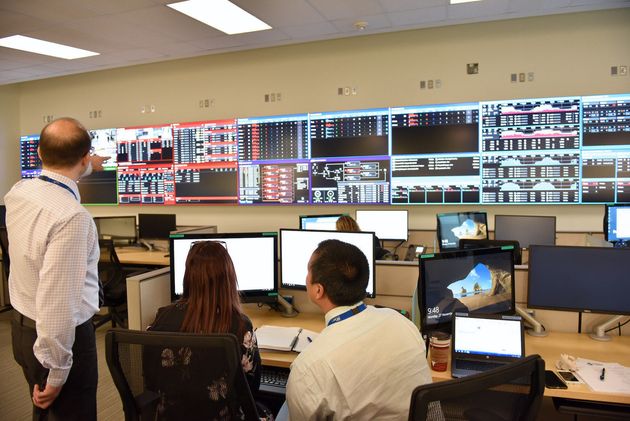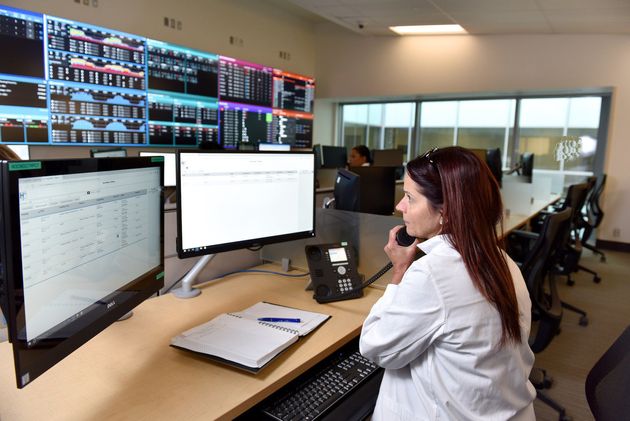
Bradford Royal Infirmary will become the first hospital in Europe to build an air traffic control style command centre to reduce waiting times and make things smoother for patients.
Using artificial intelligence, the new system will provide hospital staff with a real-time overview across the 800-bed hospital to help staff make speedy and informed decisions on managing patient care.
Around 20 staff in the so-called “command centre” will monitor a “wall of analytics” that will pull in streams of data from multiple systems across the hospital.
Just like in Hollywood films, the data will be displayed on multiple high definition screens and staff will also be able to access it on tablets and mobile devices to provide 24-7 support to busy medical teams.
The move comes as hospitals struggle to cope with rising patient numbers and limited resources.
Bradford Royal Infirmary is an 800 bed hospital and more than 96% of bed capacity is used regularly. The hospital has more than 125,000 A&E attendances a year – up by more than 40% over the past decade.
But while health unions welcome the use of technology to improve the patient experience and ease pressure on staff, they say it should not become a substitute for the human touch.

Bradford Teaching Hospitals NHS Foundation Trust is teaming up with GE Healthcare, a healthcare business which provides medical imaging and monitoring, to launch the project, in response to growing patient numbers.
Mark Ebbens, who specialises in command centres for GE Healthcare, said: “The way most people visualise mission control is like in the NASA movies with screens at the front – and that is how this [it] will work.
“People with decision making responsibilities will sit together in the same room.
“This is new for healthcare as the information provided will be in real time intelligence. In healthcare, staff are usually dealing with historical information.
“It will help staff prioritise and help orchestrate things across the hospital.”
Ebbens says they will work with the hospital to identify and focus on their most challenging problems.
He explained: “A typical problem is too many people waiting too long in emergency departments.” He said patients themselves might not see any visual difference in their treatment – but will have a smoother experience.
Algorithms will ensure staff know not only what is happening at any given moment, but will also help them predict what will happen in the near future so they can anticipate and resolve bottlenecks in care delivery before they occur.
The Command Centre will be located centrally in a refurbished space at the Bradford Royal Infirmary site.

Command centres have been adopted by several hospitals in North America including The Johns Hopkins Hospital in Baltimore and Humber River Hospital, Toronto, Canada.
Sandra Shannon, chief operating officer at Bradford Teaching Hospitals, says the trust is very keen to embrace new technological advances.
She said: “We are already seeing the benefits of the new electronic patient records system and this is the next step in the ongoing digital journey.
“The Command Centre is the only one of its kind in the way it uses real-time data and this will help us make the best use of the data we have got to make accurate decisions.
“It also stops duplication of effort and can pinpoint us to the root cause of delays so we can take immediate action.
“It will improve the patient experience by avoiding unnecessary delay so we can focus staff to move patients to the next stage of their journey.”
Prof Clive Kay, chief executive of Bradford Teaching Hospitals NHS Foundation Trust, said: “Demand for services is growing at Bradford Teaching Hospitals every year.
“The Command Centre will enable us to optimise our use of resources and improve how we move patients around the hospital for treatment and successful discharge.
“Around 350 to 400 patients come through our A&E every day and relieving pressure on our 6,000 staff means they can spend more time delivering care, and less time organising care.”
However, Unison, the public service’s union warns that while technology may be the future, it should not become a replacement for humans.
Unison head of health, Sara Gorton, said: “Using artificial intelligence and robots to make the most of limited resources in the NHS and improve the experience of patients is most definitely the future.
“But trusts need to make sure their investment focus isn’t solely on 21st century technologies while their staff struggle with outdated IT systems that belong in the previous century.
“And however efficient systems become with AI, they’ll never be a substitute for the human touch and the personal care provided by dedicated NHS staff.”
The Command Centre at Bradford will open in Spring 2019.